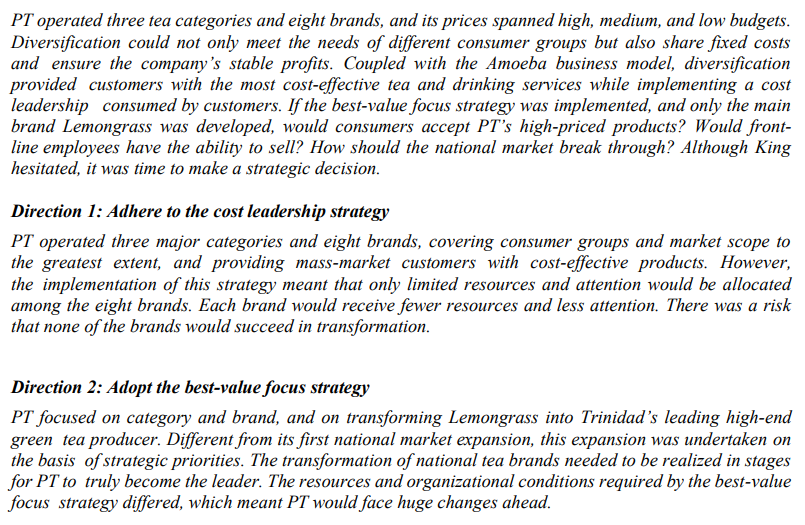The case study is based on an article about Pataka Tea Co., Ltd. (PT) - Reassessing the External Environment. This is the final part of the case study. The other parts of the case study were already submitted with the same questions Assignment Questions As of May 2018, what challenges had PT faced in recent years? Assess the factors in the internal and external environment that led to those challenges? Analyze the industry competition conditions that PT faced. Identify the key external factors that affected PT’s strategic decision. Develop a SWOT Analysis for PT to help King develop his strategy. Indicate how each of elements from the four (4)components from your SWOT, can be used to enhance PT’s competitive advantage. Each component of your SWO must have at least three (3) elements If you were Phillip King, chairman of PT, what recommendations – at least four (4), would you make to improve company performance and address the challenges you outlined in question 1. Provide clear justifications for your reasons.
The case study is based on an article about Pataka Tea Co., Ltd. (PT) - Reassessing the External Environment. This is the final part of the case study. The other parts of the case study were already submitted with the same questions Assignment Questions As of May 2018, what challenges had PT faced in recent years? Assess the factors in the internal and external environment that led to those challenges? Analyze the industry competition conditions that PT faced. Identify the key external factors that affected PT’s strategic decision. Develop a SWOT Analysis for PT to help King develop his strategy. Indicate how each of elements from the four (4)components from your SWOT, can be used to enhance PT’s competitive advantage. Each component of your SWO must have at least three (3) elements If you were Phillip King, chairman of PT, what recommendations – at least four (4), would you make to improve company performance and address the challenges you outlined in question 1. Provide clear justifications for your reasons.
Management, Loose-Leaf Version
13th Edition
ISBN:9781305969308
Author:Richard L. Daft
Publisher:Richard L. Daft
Chapter8: Strategy Formulation And Execution
Section: Chapter Questions
Problem 3CFCA
Related questions
Question
The case study is based on an article about Pataka Tea Co., Ltd. (PT) - Reassessing the External Environment.
This is the final part of the case study. The other parts of the case study were already submitted with the same questions
Assignment Questions
- As of May 2018, what challenges had PT faced in recent years? Assess the factors in the internal and external environment that led to those challenges?
- Analyze the industry competition conditions that PT faced. Identify the key external factors that affected PT’s strategic decision.
- Develop a SWOT Analysis for PT to help King develop his strategy. Indicate how each of elements from the four (4)components from your SWOT, can be used to enhance PT’s competitive advantage. Each component of your SWO must have at least three (3) elements
- If you were Phillip King, chairman of PT, what recommendations – at least four (4), would you make to improve company performance and address the challenges you outlined in question 1. Provide clear justifications for your reasons.

Transcribed Image Text:PT operated three tea categories and eight brands, and its prices spanned high, medium, and low budgets.
Diversification could not only meet the needs of different consumer groups but also share fixed costs
and ensure the company's stable profits. Coupled with the Amoeba business model, diversification
provided customers with the most cost-effective tea and drinking services while implementing a cost
leadership consumed by customers. If the best-value focus strategy was implemented, and only the main
brand Lemongrass was developed, would consumers accept PT's high-priced products? Would front-
line employees have the ability to sell? How should the national market break through? Although King
hesitated, it was time to make a strategic decision.
Direction 1: Adhere to the cost leadership strategy
PT operated three major categories and eight brands, covering consumer groups and market scope to
the greatest extent, and providing mass-market customers with cost-effective products. However,
the implementation of this strategy meant that only limited resources and attention would be allocated
among the eight brands. Each brand would receive fewer resources and less attention. There was a risk
that none of the brands would succeed in transformation.
Direction 2: Adopt the best-value focus strategy
PT focused on category and brand, and on transforming Lemongrass into Trinidad's leading high-end
green tea producer. Different from its first national market expansion, this expansion was undertaken on
the basis of strategic priorities. The transformation of national tea brands needed to be realized in stages
for PT to truly become the leader. The resources and organizational conditions required by the best-value
focus strategy differed, which meant PT would face huge changes ahead.
Expert Solution
This question has been solved!
Explore an expertly crafted, step-by-step solution for a thorough understanding of key concepts.
Step by step
Solved in 7 steps

Recommended textbooks for you

Management, Loose-Leaf Version
Management
ISBN:
9781305969308
Author:
Richard L. Daft
Publisher:
South-Western College Pub

Management, Loose-Leaf Version
Management
ISBN:
9781305969308
Author:
Richard L. Daft
Publisher:
South-Western College Pub